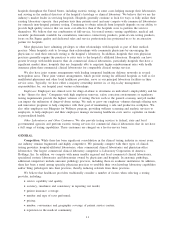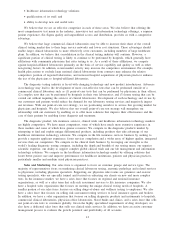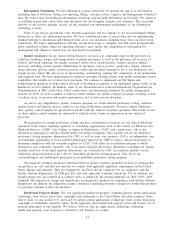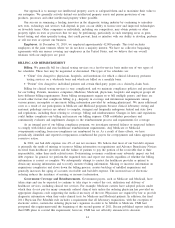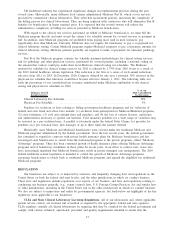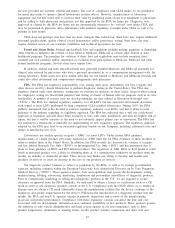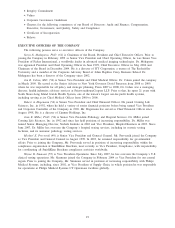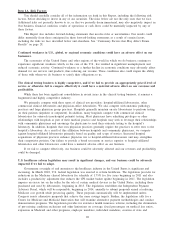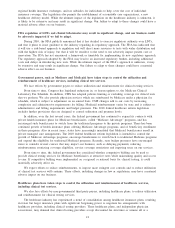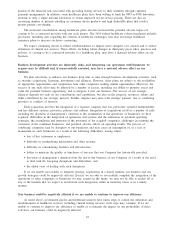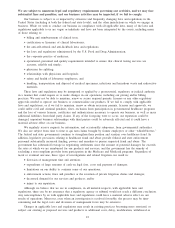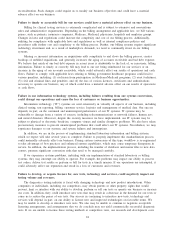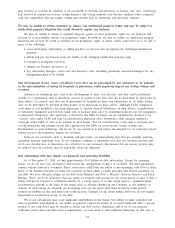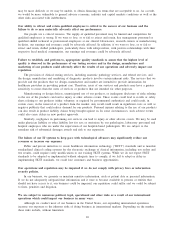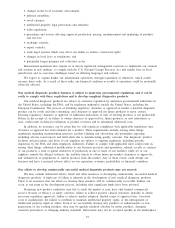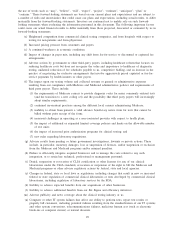Quest Diagnostics 2010 Annual Report Download - page 23
Download and view the complete annual report
Please find page 23 of the 2010 Quest Diagnostics annual report below. You can navigate through the pages in the report by either clicking on the pages listed below, or by using the keyword search tool below to find specific information within the annual report.
Item 1A. Risk Factors
You should carefully consider all of the information set forth in this Report, including the following risk
factors, before deciding to invest in any of our securities. The risks below are not the only ones that we face.
Additional risks not presently known to us, or that we presently deem immaterial, may also negatively impact us.
Our business, financial condition, results of operations or cash flows could be materially impacted by any of
these factors.
This Report also includes forward-looking statements that involve risks or uncertainties. Our results could
differ materially from those anticipated in these forward-looking statements as a result of certain factors,
including the risks we face described below and elsewhere. See “Cautionary Factors that May Affect Future
Results” on page 28.
Continued weakness in U.S., global, or regional economic conditions could have an adverse effect on our
businesses.
The economies of the United States and other regions of the world in which we do business continue to
experience significant weakness which, in the case of the U.S., has resulted in significant unemployment and
reduced economic activity. Continued weakness or a further decline in economic conditions may adversely affect
demand for our services and products, thus reducing our revenue. These conditions also could impair the ability
of those with whom we do business to satisfy their obligations to us.
The clinical testing business is highly competitive, and if we fail to provide an appropriately priced level of
service or otherwise fail to compete effectively it could have a material adverse effect on our revenues and
profitability.
While there has been significant consolidation in recent years in the clinical testing business, it remains a
fragmented and highly competitive industry.
We primarily compete with three types of clinical test providers: hospital-affiliated laboratories, other
commercial clinical laboratories and physician-office laboratories. We also compete with anatomic pathology
practices and large physician group practices. Hospitals generally maintain on-site laboratories to perform testing
on their patients (inpatient or outpatient). In addition, many hospitals compete with commercial clinical
laboratories for outreach (non-hospital patients) testing. Most physicians have admitting privileges or other
relationships with hospitals as part of their medical practice and hospitals may seek to leverage their relationships
with community physicians and encourage the physicians to send their outreach testing to the hospital’s
laboratory. In addition, hospitals that own physician practices generally require the practices to refer tests to the
hospital’s laboratory. As a result of this affiliation between hospitals and community physicians, we compete
against hospital-affiliated laboratories primarily based on quality and scope of service. Increased hospital
acquisitions of physician practices enhance physician ties to hospital-affiliated laboratories and may strengthen
their competitive position. Our failure to provide a broad test menu or service superior to hospital-affiliated
laboratories and other laboratories could have a material adverse effect on our business.
If we fail to compete effectively, our business could be adversely affected and our revenues and profitability
could be damaged.
U.S. healthcare reform legislation may result in significant changes, and our business could be adversely
impacted if we fail to adapt.
Government oversight of and attention to the healthcare industry in the United States is significant and
increasing. In March 2010, U.S. federal legislation was enacted to reform healthcare. The legislation provides for
reductions in the Medicare clinical laboratory fee schedule of 1.75% for five years beginning in 2011 and also
includes a productivity adjustment that reduces the CPI market basket update beginning in 2011. The legislation
imposes an excise tax on the seller for the sale of certain medical devices in the United States, including those
purchased and used by laboratories, beginning in 2013. The legislation establishes the Independent Payment
Advisory Board, which will be responsible, beginning in 2014, annually to submit proposals aimed at reducing
Medicare cost growth while preserving quality. These proposals automatically will be implemented unless
Congress enacts alternative proposals that achieve the same savings targets. Further, the legislation calls for a
Center for Medicare and Medicaid Innovation that will examine alternative payment methodologies and conduct
demonstration programs. The legislation provides for extensive health insurance reforms, including the elimination
of pre-existing condition exclusions and other limitations on coverage, fixed percentages on medical loss ratios,
expansion in Medicaid and other programs, employer mandates, individual mandates, creation of state and
20



